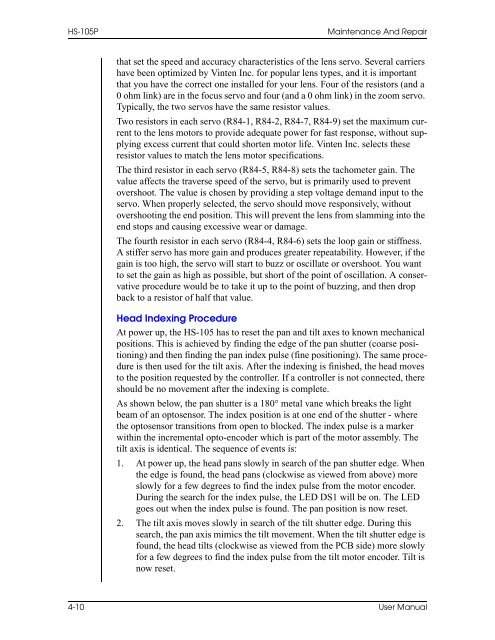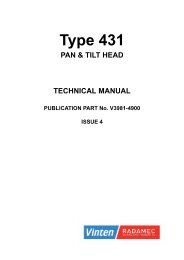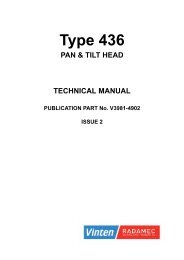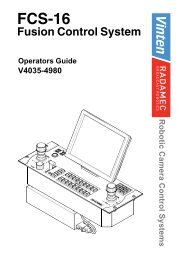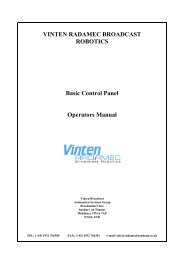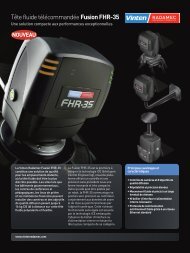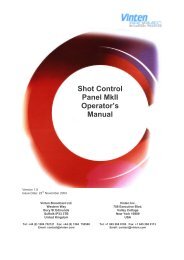HS-105P, PE. SA AutoCam™ Pan & Tilt Head - Vinten Radamec
HS-105P, PE. SA AutoCam™ Pan & Tilt Head - Vinten Radamec
HS-105P, PE. SA AutoCam™ Pan & Tilt Head - Vinten Radamec
You also want an ePaper? Increase the reach of your titles
YUMPU automatically turns print PDFs into web optimized ePapers that Google loves.
<strong>HS</strong>-<strong>105P</strong> Maintenance And Repair<br />
that set the speed and accuracy characteristics of the lens servo. Several carriers<br />
have been optimized by <strong>Vinten</strong> Inc. for popular lens types, and it is important<br />
that you have the correct one installed for your lens. Four of the resistors (and a<br />
0 ohm link) are in the focus servo and four (and a 0 ohm link) in the zoom servo.<br />
Typically, the two servos have the same resistor values.<br />
Two resistors in each servo (R84-1, R84-2, R84-7, R84-9) set the maximum current<br />
to the lens motors to provide adequate power for fast response, without supplying<br />
excess current that could shorten motor life. <strong>Vinten</strong> Inc. selects these<br />
resistor values to match the lens motor specifications.<br />
The third resistor in each servo (R84-5, R84-8) sets the tachometer gain. The<br />
value affects the traverse speed of the servo, but is primarily used to prevent<br />
overshoot. The value is chosen by providing a step voltage demand input to the<br />
servo. When properly selected, the servo should move responsively, without<br />
overshooting the end position. This will prevent the lens from slamming into the<br />
end stops and causing excessive wear or damage.<br />
The fourth resistor in each servo (R84-4, R84-6) sets the loop gain or stiffness.<br />
A stiffer servo has more gain and produces greater repeatability. However, if the<br />
gain is too high, the servo will start to buzz or oscillate or overshoot. You want<br />
to set the gain as high as possible, but short of the point of oscillation. A conservative<br />
procedure would be to take it up to the point of buzzing, and then drop<br />
back to a resistor of half that value.<br />
<strong>Head</strong> Indexing Procedure<br />
At power up, the <strong>HS</strong>-105 has to reset the pan and tilt axes to known mechanical<br />
positions. This is achieved by finding the edge of the pan shutter (coarse positioning)<br />
and then finding the pan index pulse (fine positioning). The same procedure<br />
is then used for the tilt axis. After the indexing is finished, the head moves<br />
to the position requested by the controller. If a controller is not connected, there<br />
should be no movement after the indexing is complete.<br />
As shown below, the pan shutter is a 180° metal vane which breaks the light<br />
beam of an optosensor. The index position is at one end of the shutter - where<br />
the optosensor transitions from open to blocked. The index pulse is a marker<br />
within the incremental opto-encoder which is part of the motor assembly. The<br />
tilt axis is identical. The sequence of events is:<br />
1. At power up, the head pans slowly in search of the pan shutter edge. When<br />
the edge is found, the head pans (clockwise as viewed from above) more<br />
slowly for a few degrees to find the index pulse from the motor encoder.<br />
During the search for the index pulse, the LED DS1 will be on. The LED<br />
goes out when the index pulse is found. The pan position is now reset.<br />
2. The tilt axis moves slowly in search of the tilt shutter edge. During this<br />
search, the pan axis mimics the tilt movement. When the tilt shutter edge is<br />
found, the head tilts (clockwise as viewed from the PCB side) more slowly<br />
for a few degrees to find the index pulse from the tilt motor encoder. <strong>Tilt</strong> is<br />
now reset.<br />
4-10 User Manual


